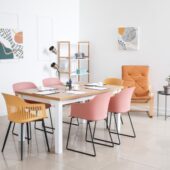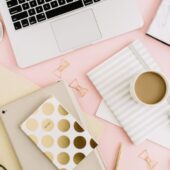
Colors are a matter of personal preference, but certain colors affect us in different ways and you can use this to your advantage when decorating your office spaces. Here are some suggestions for using specific colors to enhance different areas for different effect.
RED
Red is known for being an appetite and energy stimulator, so this color is best used in environments with a lot of activity such as break rooms and busy meeting areas. Conversation may be enhanced by pops of this warm, exciting color.
ORANGE
Orange is thought of as a brain stimulating color that can help boost creativity. Like red, it may be a little harsh for an office environment but might energize an exercise room or break room.
YELLOW
Yellow is a happy, uplifting color but should be used in moderation; bright yellow can be jarring on the eyes and in some studies has caused anger or frustration in people. Kitchens, bathrooms, and hallways are great areas for yellow but avoid covering large spaces or use muted hues of the color.
GREEN
Green is second only to blue as a cross-culturally positive color. It is refreshing, calming, and thought to promote concentration. Whether introducing some office plants or using green desktop artwork, this color is recommended for your main working area.
BLUE
Blue is thought to be the best color for productivity and works in almost any environment. Blue evokes feelings of stability, quality, and cleanliness and comes in many warmer or cooler shades depending on the effect you want. Lighter blues can be calming while brighter turquoise blues can liven up a communal space.
PURPLE
Purple is yellow’s opposite and is a restful, luxurious color that many people associate with power and sophistication. Use it in moderation to add a polished and calming atmosphere to waiting rooms and offices.
NEUTRALS
Black, white, gray, and brown are all useful colors to use as a base for any area. These colors blend in to the background and are used to balance and complement other colors. Black is authoritative and intimidating in large quantities, but adds depth as an accent. White and gray can be refreshing and calming but may seem sterile without the contrast of brighter colors. Choose one or two primary colors and fill in the rest with neutral colors- go with your gut for what will work best in your space.
If you are unsatisfied with your office atmosphere, ask our EON Environments interior design team for suggestions on how to coordinate the colors in your office with furniture and accessories for a sophisticated and productive work space. View our past projects HERE.
Sources: http://ayearofproductivity.com/angela-wright-interview/ http://www.huffingtonpost.com/vanessa-van-edwards/color-and-mood_b_2088728.html http://freshome.com/2007/04/17/room-color-and-how-it-affects-your-mood/ http://www.scienceofpeople.com/2013/01/10-ways-color-affects-your-mood/



